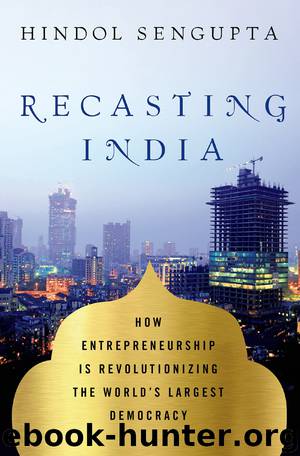Recasting India by Hindol Sengupta

Author:Hindol Sengupta
Language: eng
Format: epub
Publisher: Palgrave Macmillan
Published: 2014-10-12T16:00:00+00:00
CHAPTER 6
MODELS IN VILLAGES
The cow peed in riverine spurts, sloshing pale urine that seeped into the dust, making it dark. “See—turning like chocolate color,” said the man beside me happily. Srikant Bangar, 30, stared at his cow with the kind of unadulterated affection Lord Emsworth bestowed on the Empress of Blandings in P. G. Wodehouse’s novels.
I am in Hiware Bazar,1 a six-hour drive from India’s financial capital, Bombay. To travel to Hiware Bazar, one drives out—preferably at first light as I did, to avoid the paralyzing Bombay traffic—along the Bombay-Pune highway for about three hours. This is one of the best expressways in the country and was India’s first six-lane highway when it opened in 2002.
The road snakes across the Sahyadri mountain range on the Western Ghats, and on a good day, you can do the trip from Bombay to the university and automobile town of Pune in two hours flat. For years it was one of the few pieces of infrastructure that India could be proud of, but the month I went to Hiware Bazar, the expressway was in the news for the wrong reasons.
The pitch of protests against illegal and usurious toll collection—more than Rs 500 for one round trip to Pune—had reached violent levels. Two prominent opposition parties, the Shiv Sena and the Maharashtra Navnirman Sena, had asked its supporters not to pay the toll. This often translated into riotous attacks on toll booths by party activists. Some research showed that travelers were being charged thousands of crores more than what they should pay through illegal tolls imposed by a nexus of government leaders and real estate developers.
But even so, travel on the expressway is one of the few, and very far between, pleasures of good public infrastructure in India. From Pune, Hiware Bazar is another nearly three-hour drive toward the town of Ahmednagar—the village is located just before the town. This road is like the old highways of India, crowded and often pockmarked—none of it resembles the Bombay-Pune expressway corridor.
A few kilometers before Ahmednagar, the car turns into a small lane and then into fields in places where roads don’t exist at all. All very classic rural India until all of a sudden, a few meters from the village, a well-paved, bump-free road pops up again. This leads straight into a village that, in fact, does not seem like an Indian village at all.
The roads are paved and almost entirely pothole free. In fact, they are far better than almost any road I have seen in Bombay. There are no open drains, no garbage dumped at corners, no dirty buzzing flies, no filthy puddles and no stench.
As an Indian, with years of having traveled in and visited Indian villages—often utterly foul and despondent places—coming to Hiware Bazar is almost surreal. In a country where nearly 400 million people, most of them in Indian villages, have never had electricity, Bangar’s cowshed—in fact, every cowshed in the village—has solar-powered lighting. So do all its dozen or so temples and the one mosque that villagers built for the only Muslim family in the area.
Download
This site does not store any files on its server. We only index and link to content provided by other sites. Please contact the content providers to delete copyright contents if any and email us, we'll remove relevant links or contents immediately.
| Arms Control | Diplomacy |
| Security | Trades & Tariffs |
| Treaties | African |
| Asian | Australian & Oceanian |
| Canadian | Caribbean & Latin American |
| European | Middle Eastern |
| Russian & Former Soviet Union |
The Secret History by Donna Tartt(18844)
The Social Justice Warrior Handbook by Lisa De Pasquale(12141)
Thirteen Reasons Why by Jay Asher(8792)
This Is How You Lose Her by Junot Diaz(6794)
Weapons of Math Destruction by Cathy O'Neil(6142)
Zero to One by Peter Thiel(5685)
Beartown by Fredrik Backman(5596)
The Myth of the Strong Leader by Archie Brown(5425)
The Fire Next Time by James Baldwin(5248)
How Democracies Die by Steven Levitsky & Daniel Ziblatt(5127)
Promise Me, Dad by Joe Biden(5087)
Stone's Rules by Roger Stone(5026)
A Higher Loyalty: Truth, Lies, and Leadership by James Comey(4843)
100 Deadly Skills by Clint Emerson(4840)
Rise and Kill First by Ronen Bergman(4701)
Secrecy World by Jake Bernstein(4644)
The David Icke Guide to the Global Conspiracy (and how to end it) by David Icke(4624)
The Farm by Tom Rob Smith(4435)
The Doomsday Machine by Daniel Ellsberg(4415)
